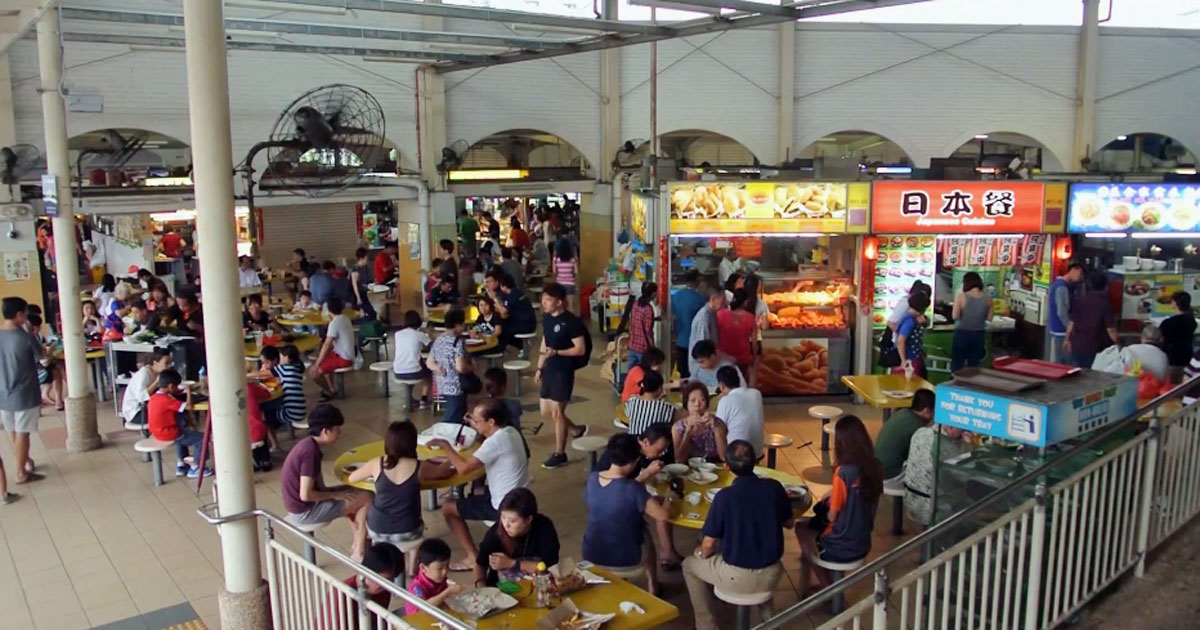Hawker food champion, real culture advocate and consultant KF Seetoh of Makansutra has penned a heartfelt open letter on Oct. 9 addressed to the Senior Minister of State Amy Khor.
Written on behalf of Singapore's hawkers, the open letter is titled, "Please Preserve our Public Hawker Centres".
Not-for-profit enterprise expensive for hawkers
The main gripe is against the trend of Social Enterprise Hawker Centres sprouting up all over the island as of late, which have been touted as so-called "not-for-profit social enterprises" -- but are increasingly seen as anything but not-for-profit.
To date, there are 13 hawker centres and markets run by social enterprises, including Fei Siong, NTUC Foodfare, Timbre, Koufu, and Kopitiam.
And they have been getting massive bad press, as hawkers operating in these entities have been squeezed financially left, right and centre -- and are voicing out.
What this open letter shows
In this latest open letter, Seetoh got hold of the actual contractual terms and conditions in black and white that hawkers operating in not-for-profit social enterprises have to put up with, which consists of plenty of miscellaneous fees and hidden operating costs.
What are private social enterprise hawker centres?
Hawker centres run by private social enterprises are meant to theoretically marry the best of both worlds.
They keep food affordable and available for the masses with constant fresh injections of culinary ideas, while operating according to free market competition rules with little government oversight, as well as discharging social obligations by catering to the less well-off.
In other words, good old fashioned hawker centres that were the purview of the governmental National Environment Agency (NEA) are slowly being transferred into the hands of private entities, and in the process, costs of operating a hawker stall have been escalating.
The point Seetoh tried to make is that Social Enterprise Hawker Centres have rentals and fees comparable to other private food courts and halls in Singapore, but they are nowhere as cheap when compared to the other established NEA-run public hawker centres and coffee shops.
Here are some of the costs incurred by hawkers in not-for-profit hawker centres as highlighted by Seetoh:
1. Penalty for giving up stall
One of the gripes of hawkers who have quit or are quitting as tenant of a Social Enterprise Hawker Centre is the termination costs penalty.
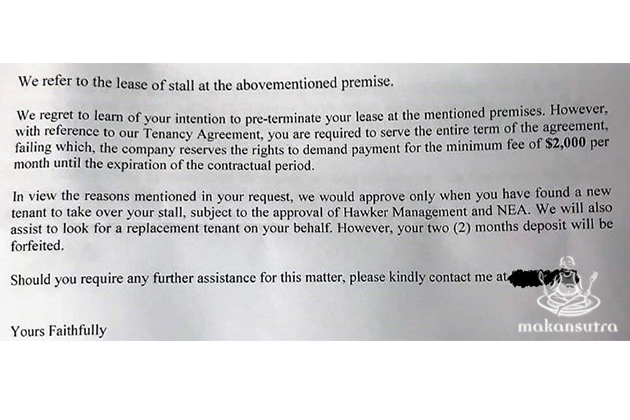
This detail in the contract states that the tenant has to pay S$2,000 a month for early termination until the contract period expires.
Seetoh also elaborated that S$2,000 is just the basic rental incurred by the hawker when operating in the social enterprise hawker centre.
When additional charges and miscellaneous fees are included, the hawker effectively pays close to S$4,000 a month in rental and fees.
In other words, there are two choices: Hawkers pay S$2,000 a month for quitting early until the contract duration runs out, or carry on paying S$4,000 a month to operate until the contract ends.
2. Hawkers foot the cost of S$0.20 for each tray customer returns
The cost of encouraging civic-mindedness in customers is ultimately borne by the hawkers.
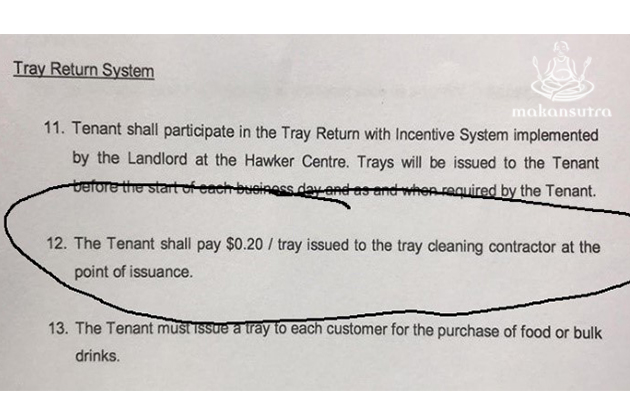
The hawker has to pay 20 cents out of his or her own pocket when the customer returns a tray due to the cashback system implemented.
The hawker can pay between S$400 and S$800 a month just for tray returns alone.
3. Landlord can raise fees at any time and give short notice
This spaghetti alphabet soup of lawyerly words just means the landlord can increase payments at anytime because they are legally entitled to as the contract is binding.
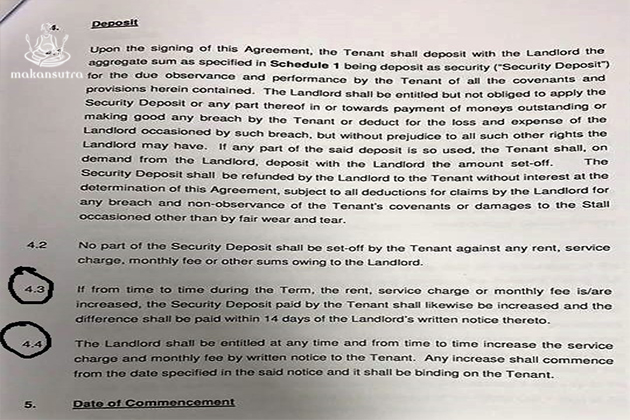
This puts hawkers at a severe disadvantage as there is little they can do to project revenues, profits and losses, especially when costs becomes a moving target they have to hit every month and it can potentially escalate at any time.
This is bearing in mind that not all hawkers can read and understand these jargon-laden terms and conditions without getting help by hiring a lawyer to read the terms and conditions for them.
4. Hawkers have to pay for the tenancy agreement
Adding insult to injury, the hawkers are asked to pay S$267.50 for the preparation of the tenancy agreement consisting of spaghetti alphabet soup of lawyerly words.
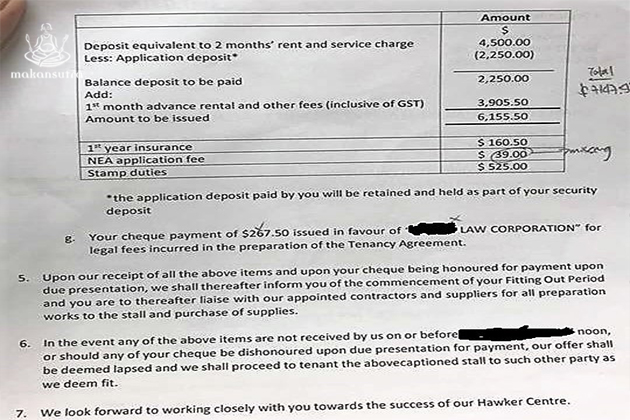
[related_story]
Solution
Seetoh's call to action is simple: He is asking the Senior Minister of State to reconsider the current arrangement, and taking the hawker centres out of private hands and putting them back into the hands of NEA, like how it always had been.
Seetoh wrote that there are almost 30,000 hawker street food licenses in Singapore and 6,000 are sited in public-owned hawker centres.
The other 24,000 hawker licenses attached to stalls operating in privately-owned enterprises should take their cue from how these minority 6,000 stalls are run by the NEA, like they always had.
Currently, NEA still uses a tender bidding system to determine rental rates, while on the other hand, social enterprise operators are free to set their own rental rates.
Although not specifically spelt out by Seetoh as this issue is still in its early days, he is sounding a warning of ultimately avoiding a diluted form of "regulatory capture".
Regulatory capture occurs when a regulatory agency ends up advancing the commercial interest of a group at the expense of the public interest -- even though the regulatory agency was initially created to act on behalf of the public.
But a more understandable and salient issue to grab the public's attention is the threat this new arrangement of Social Enterprise Hawker Centres is posing to Singapore's hawker culture, which is one of the rare vestiges of organic national culture that is left standing in the 21st century that is worth preserving.
The threat is real. And it has been called out.
You can read the open letter here.
Update:
All photos via Makansutra except top photo
If you like what you read, follow us on Facebook, Instagram, Twitter and Telegram to get the latest updates.
